
Dealing With the Deceased Menu: 1 2 3 4 5 6 Next>>
Dealing With the Deceased in the Golden Age of Piracy, Page 5
Burial Procedure - Firing Guns
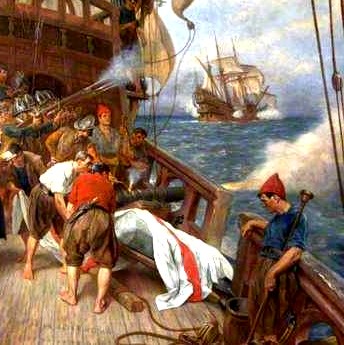
Artist: Thomas Davidson
Firing Muskets and Cannons During Francis Drake's Burial
at Sea in 1596 (Late 19th/early 20th Century)
Captain Luke Ward "described shooting cannon as part of the ceremony for a man who died at sea"1 during his account of an attempted voyage to China in 1582-3.2 When Francis Drake died in 1596, one account noted that "all the Cannons in the Fleet were discharged according to the custome of all Sea Funerall obsequies"3. So this tradition has a long pedigree.
Of all the elements of the burial ceremony, none is as widely supported in the golden age of piracy sea literature as the firing of guns. Agreeing in tone with the description of Drake's funeral, Boteler's Dialogues in 1635 explained that it was customary "upon the death either of the Captain, Master, Master-Gunner, or any chief officer... [to give] farewell with some guns; the which (as aforenoted) are always to be of an even number."4 William Funnell tells of a captain whose "Body was buried ashoar at the Watering-place, with the usual Ceremony of firing of Guns"5.
1 David J. Stewart, The Sea Their Graves, 2011, p. 107; 2 John Knoxe Laughten, "Warde, Luke", Dictionary of the National Biography, Vol. 59, gathered from the internet 10/12/15; 3 A Full Relation of Another Voyage into the West Indies made by Sir Francis Drake, Printed at London for Nicholas Bourne, 1652, p. 58; 4 Nathaniel Boteler [Butler], Boteler’s Dialogues, Edited by W. G. Perrin, Navy Records Society, 1929, p. 268; 5 William Funnell, A Voyage Round the World, p. 226
Burial Procedure - Firing Guns: Cannons
The tradition of shooting cannons to send off the dead appears to have been primarily performed for officers and other notables.
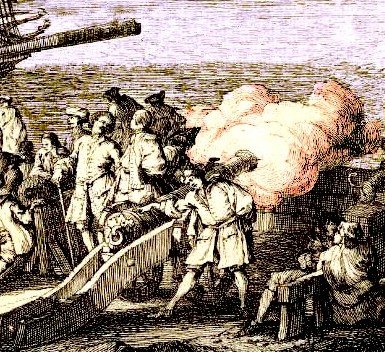
Artist: Jacques Rigaud Jacque
Firing a Cannon, Alere au Depart Avec Coup de Canon (1750)
Chaplain Henry Teonge details the burial of the ship's Captain, who was carried to land in a barge. "At our going off our ship fired forty guns; the Hollanders at least a hundred."1 During the burial of the ship's lieutenant, Teonge explains, "Severall peales of greate gunns rang his funerall knell."2
In the two detailed descriptions of burials from his slaving vessel, merchant captain Thomas Phillips mentioned the use of ship's guns to honor the dead. Both occured after burial. The first was for his brother, who was buried at sea. Once he had been rowed a quarter of a mile from the ship, the ceremony was celebrated, "I help’d to commit his body to the deep, which was the last office lay in my power to do for my dear brother. …and the East India merchant fir’d ten guns."3 The second was the burial of Thomas Shurley, captain of Phillips' consort ship, which sounds as if it must have been quite the cacophony. Phillips explains that "after he was bury'd... his own ship fired 30 guns, the Hannibal [Phillip's ship] 26, [the land-based] Acra fort [fired] 20, and the Dutch and blacks [of the fort fired] 16 each"4.
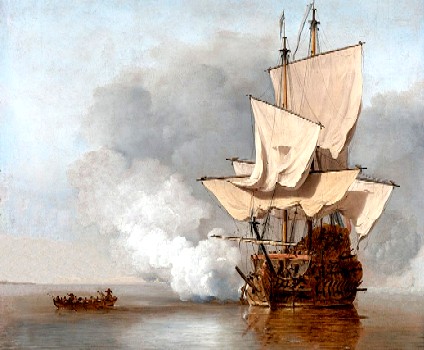
Artist: Willem van de Velde the Younger - Ship Firing a Salute (1707)
Sometimes 'minute gun' rounds were fired to honor the dead. The Merriam-Webster dictionary explains that a minute gun is "a discharge of a cannon repeated at intervals of a minute usually in connection with the funeral of a general or flag officer"5. Teonge includes an account of using minute guns when the body of their boatswain Richard Capp was being rowed ashore for burial. "[H]e had 9 gunns [fired for him] which were fyred at a minut's distance."6
Phillips goes one better than traditional minute guns. He explains that captain Shurley "was handsomely bury’d in A[c]cra castle, a la Soldado, his own ship firing guns at half a minute distance, during the time the corpse was rowing ashore"7. Similarly, as Phillips' brother was being rowed out to his burial at sea, his ship "the Hannibal fired sixteen guns at 1/2 minute distance of time, which was the number of years he had liv’d in this uncertain world."8 When pirate captain John Halsey was buried "as many minute guns [were] fired as he was years old, viz. 46"9.
1 Henry Teonge, The Diary of Henry Teonge, Chaplain on Board H.M.’s Ships Assistance, Bristol, and Royal Oak, 1675-1679 Teonge, 1825, p. 246; 2 Teonge, p. 270; 3 Thomas Phillips, 'A Journal of a Voyage Made in the Hannibal', A Collection of Voyages and Travels, Vol. VI, Awnsham Churchill. ed., p.196; 4 Phillips, p. 212-3; 5 "minute gun" merriam-webster.com, gathered 10/12/15; 6 Teonge, p. 101; 7 Phillips, p. 212; 8 Phillips, p. 196; 9 Captain Charles Johnson, The History of the Pirates, 1826, p. 103;
Burial Procedure - Firing Guns: Small Arms
In addition to the firing of larger guns at the funeral of men of rank, small arms such as muskets, rifles and pistols were fired during funeral ceremonies, although they were generally fired later in the ceremony than the large guns.
Historian Zachary Friedenburg explains with regard to burials at sea, "Three guns were fired as a tribute, as the bodies sank."1 When they buried the body of their supercargo in Aden, merchant sailor Francis Rogers explains that they gave him "3 volleys of small shot over the grave, to the no small astonishment of the admiring Arabians."2 Upon the death of their Master [the ship's Master or Sailing Master is responsible for navigation of the vessel] John Hilliard in 1681, Bartholomew Sharp's men buried him "in the best manner we could on Shoar, solemnizing his Obsequies with three Volleys of small Shot."3
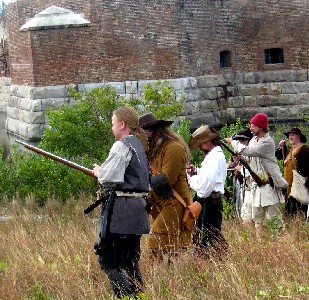
Photo: Mission
Pirate Re enactors Preparing to Fire a Volley
In addition to the minute rounds fire for the burial of Richard Capp in 1675, Teonge notes that "he had 4 peales [rounds] of muskett shott", fired by "Halfe the ship's company" who had followed the procession from the ship "with their musketts in the right posture, going after the corps[e]"4.
These rounds of small shot were not restricted to officer's ceremonies. As the corpses of Woodes Rogers' 21 year old brother John and 'one of our Sailors' were put over the side, the crew on the ships were "firing each some Volleys of small Arms."5 Sailor Henry Shergall, who fell to his death while going to the spritsail top in 1680, was buried on shore with his fellow buccaneers "giving him several volleys for his funeral rites, according to custom."6
Some of the accounts even suggest the method for firing rounds of small arms at funerals. For buccaneer William Cammock, who died from fever in 1679, his fellow sailors "buried him in the sea, according to the usual custom of mariners, giving him three French volleys for his funeral."7 The pirate's funeral given for John Halsey similarly mentions the use of a French volleys; upon being put into the ground he was given "three English vollies, and one French volley of small arms."8
The difference between a French and English volley of guns is not exactly clear. Pirate historian Ed Fox believes (but is not certain) that a French volley involves shooting all the guns simultaneously while an English volley involves a rolling fire9. Descriptions of battles that took place after the golden age of piracy associate rolling fire with the English, with "each rank firing in turn, while the others reloaded."10
1 Zachary B. Friedenberg, Medicine Under Sail, p. 14; 2 Francis Rogers, "The Journal of Francis Rogers", Three Sea Journals of Stuart Times, Bruce S. Ingram, editor, 1936, p. 169; 3 Bartholomew Sharp, "Captain Sharp's Journal of His Expedition," from William Hacke's A collection of original voyages, p. 45; 4 Henry Teonge, The Diary of Henry Teonge, Chaplain on Board H.M.’s Ships Assistance, Bristol, and Royal Oak, 1675-1679 Teonge, 1825, p. 101; 5 Woodes Rogers, A Cruising Voyage Round the World, 2004, p. 90; 6 Alexandre Exquemelin, The History of the Buccaneers of America, 1856, p. 290; 7 Exquemelin, p. 248; 8 Captain Charles Johnson, The History of the Pirates, 1826, p. 103; 9 Private message discussion with Ed Fox, 10/12/15; 10 Earl John Russell Russell, Memoirs of the Affairs of Europe: From the Peace of Utrecht, Volume 2, 1829, p. 206
Burial Procedure - Prayers for the Dead
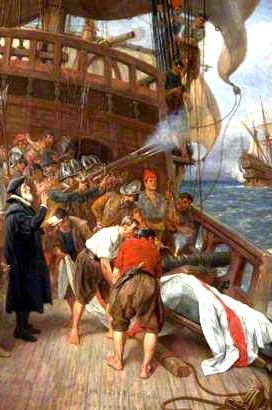
Artist: Thomas Davidson
Priest Praying over Francis Drake's Burial
at Sea in 1596 (Late 19th/early 20th Century)
The heart of a burial ceremony were the prayers for the dead. For the burial of Richard Capps, naval chaplain Henry Teonge says, "I buryed him according to our Common Prayer booke."1
During the golden age of piracy, editions of this book that were published were based on the 1662 edition of the Book of Common Prayer which included the service for burial at sea. "This version became the standard form used aboard English and American vessels throughout the Age of Sail and remains the basis for the burial at sea ceremony as it is conducted today."2 The prayers would be read by a chaplain if a ship had one, or the ship's captain or another officer if they didn't.3
Most of the ceremony described in the Common Book of Prayer was the same on land and at sea. It began with the reading of John 11:25-26, followed by Job 19:25-27, I Timothy 6:7 and Job 1:21. After these readings Psalms 39 and 90 could be read - either one of them or both of them. Then a passage from I Corinthians chapter 15 was read. Following that, the Common Book of Prayer says, "When they come to the grave, while the corps is made ready to be laid into the earth" and Job 14:1-2 is read followed by a prayer that strung a variety of scripture passages about death together.4
The next part of the prayers for the dead involve the actual burial of the corpse. The normal (land-based) ceremony says,
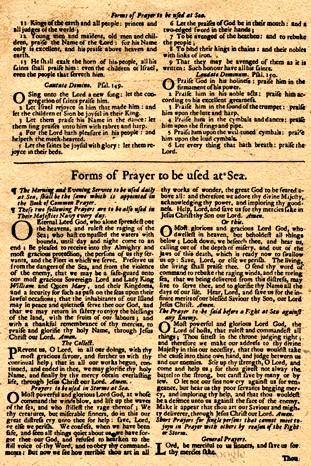
Beginning of the Prayers to Be Used at Sea in The
Book of Common Prayer (1693)
Then while the earth shall be cast upon the body by some standing by, the Priest shall say,
For as much as it hath pleased Almighty God of his great mercy to take unto himself the soul of our dear brother here departed, we therefore commit his body to the ground; earth to earth, ashes to ashes, dust to dust, insure and certain hope of the resurrection to eternal life through our Lord Jesus Christ, who shall change our vile body, that it may be like onto his glorious body, according to the mighty working whereby he is able to subdue all things to himself.5
This is where the ceremony for a burial at sea deviates from the normal ceremony. A special section explains,
“The Office in the Common Prayer-book may be used; Only instead of these words (We therefore commit his body to the ground, earth to earth, &c) say,
We therefore commit his body to the deep, to be turned into corruption, looking for the resurrection of the body, (when the sea shall give up her dead) and the life of the world to come through Our Lord Jesus Christ; who at his coming shall change our vile body, that it may be like his glorious body, according to the mighty working, whereby he is able to subdue all things to himself.”6
It would be tempting to say that prayers for the dead wouldn't be included for burials of men such as privateers and pirates, yet we have examples of each. When privateer Woodes Rogers' brother and another sailor were interred at sea in 1709, Rogers says "About twelve we read the Prayers for the Dead, and threw my dear Brother over-board, with one of our Sailors"7. When Captain John Halsey died of a fever in 1716 he "was buried with great solemnity and ceremony; the prayers of the church of England was read over him"8. Both of merchant captain Thomas Phillips' notables - his brother and the captain of his consort ship - were read over. For his brother, Phillips mentions that "the prayers of the church [were] read"9 and for consort Captain Shurley, he "was bury'd, according to the service of the church of England"10.
1 Henry Teonge, The Diary of Henry Teonge, Chaplain on Board H.M.’s Ships Assistance, Bristol, and Royal Oak, 1675-1679, 1825, p. 101; 2 David J. Stewart, The Sea Their Graves, 2011, p. 107; 3 Stewart, p. 123; 4,5 "The Order for the Burial of the Dead," Common Book of Prayer, 1693, not paginated; 6 "At the Burial of their Dead at Sea" Common Book of Prayer, 1693, not paginated; 7 Woodes Rogers, A Cruising Voyage Round the World, 1712, p. 160; 8 Captain Charles Johnson, The History of the Pirates, 1826, p. 103; 9 Thomas Phillips, 'A Journal of a Voyage Made in the Hannibal', A Collection of Voyages and Travels, Vol. VI, Awnsham Churchill. ed., p.196; 10 Phillips, p. 212
Burial Procedure - Committing the Body at Sea
"This same day Sir Francis Drake, our General, departed this life whose death was exceedingly deplored, his interment was after this manner: His Corps being laid in a Cophin of Lead, he was let downe into the Sea..." (A Full Relation of Another Voyage into the West Indies made by Sir Francis Drake, Printed at London for Nicholas Bourne, 1652, p. 58)
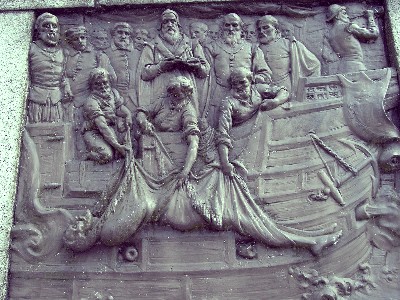
Artist: Joseph Boehm
Burial Of Sir Francis Drake at Sea, Tavistock Monument (19th c.)
A couple of the accounts of burials at sea contain interesting comments about how a body was interred. For example, Drake's body almost sounds as if it was gently lowered into the ocean based on the above quote. This is mirrored (and rather over-emphasized) in a 19th century carving showing the burial of Drake by Joseph Boehm, which can be seen at left. (This purpose of this carving is clearly not to portray accuracy as it also fails to show Drake in his lead coffin.)
Most of the accounts of sea burial which describe the interment are far less delicate in tone. While describing the burial of their cook, Francis Rogers explained that once he was sewn into his bed clothes, "we heaved him overboard"1. Silas Told describes several sea burials in such blunt terms. After one sailor had been sewn into his hammock they "threw him overboard"2 and the female companion of disliked captain who died at sea was "thrown overboard with a bag of ballast at her feet".3 However, upon describing the burial of a captain he respected, Told explained that the man was "committed to the great deep"4. Clearly his feelings for the deceased colored Told's description of their sinking.
Merchant captain Thomas Phillips talks about two burials at sea,
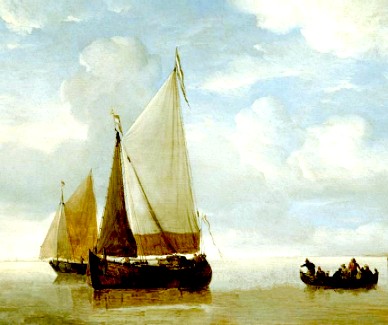
Artist: Willem van de Velde II - Small Ships With Boat Rowing (c. 1662)
noting in both of them that the corpses were rowed away from the ship before being put overboard. The first is the more vague, explaining that after sailor Thomas Cronow died of wounds received in a battle, "He was row'd some distance from the ship, and his body committed to the deep."5 The second, detailing the burial of Phillips' brother at sea, explains that they "row’d the corpse about ¼ of a mile from the ship to seaward"6 before putting him into the water.
Edward Barlow had a tendency to muse upon the more gloomy aspects of death after a body had slid into the water. He explained that a merchant who had died during a voyage "was thrown overboard, his honor being washed away, and all his riches affording him no better grave than the wide ocean"7.
Barlow likewise mourned the end of a seaman's life explaining that at his funeral, the sailor's shipmates "heave him overboard, wishing his poor soul at rest, not having a minister to read over his grave, nor any other ceremonies, but praying to God for the forgiveness of his sins, and there he hath a grave many times wide and big enough, being made meat for the fishes of the sea as well as for the worms on land."8 (Barlow is describing a funeral aboard
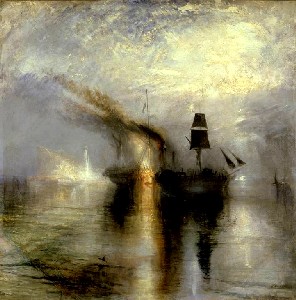
Artist: Joseph Mallord William Turner
Peace - Burial at Sea, Painted Upon the Ocean Interment of
the
Artist's Friend David Wilkie (1842)
a merchant ship, where the captain would probably have read the burial rights instead of a minister.)
Thomas Gage gives quite a vivid description of how John de la Curva was buried at sea in his 1677 book:
...his Corpse being held out to Sea on the Ship side, with Ropes ready to let him fall, all the Ship crying out three times, buen Viaci ["Bon voyage"] (that is a good Voiage) to his Soul chiefly, and also to his Corpse ready to Travel to the deep to feed the Whales: at the first cry all the Ordnance were shot off, the Ropes on a suddain loosed and John de la Curva with the weight of heavy Stones plunged deep into the Sea, whom no mortal eyes ever more beheld.9
Surgeon Johann Dietz provides a much less poetic outline of burial at sea when describing the funeral of a carpenter, whom Dietz makes a point of saying was an atheist. "There was very little ado made about the matter; we carried him upon deck, bound him to a plank, and four or more men seizing it, they sang : 'Hory sond, Hory sond, Hory see,' —and therewith pushed him overboard into the sea, whereupon he floated in the wake of the ship."10
1 Francis Rogers, "The Journal of Francis Rogers", Three Sea Journals of Stuart Times, Bruce S. Ingram, editor, 1936, p. 163; 2 Silas Told, An Account of the Life, and Dealings of God with Silas Told &c., 1786, p. 12; 3 Told, p. 23; 4 Told, p. 30; 5 Thomas Phillips, 'A Journal of a Voyage Made in the Hannibal', A Collection of Voyages and Travels, Vol. VI, Awnsham Churchill. ed., p.188; 6 Phillips, p. 196; 7 Edward Barlow, Barlow’s Journal of his Life at Sea in King’s Ships, East and West Indiamen & Other Merchantman From 1659 to 1703, Volume I, 1659-1677, 1934, p. 223; 8 Barlow, p. 214; 9 Thomas Gage, A New Survey of the West Indies, 1677, p. 44; 10 Johann Dietz, Master Johann Dietz, Surgeon in the Army of the Great Elector and Barber to the Royal Court, p. 148
Burial Procedure - A Pirate's Burial
Since the discussion of the details of burial have been divided into their various elements, the reader may have come away from this section with a disjointed view of the ceremony. There is one account of a pirate's burial which is most descriptive, incorporating many of the elements discussed - that of Captain John Halsey. Although the various parts of this account have already been used to support individual points, it seems fitting to present it here in its entirety as a way to close this section and to give a cohesive view of a sailor's burial ceremony.
As to Capt. [John] Halsey, ...he fell ill of a fever, died and was buried with great solemnity and ceremony; the prayers of the church of England was read over him, colours were flying, and his sword and pistol laid on his coffin, which was covered with a ship's jack; as many minute guns fired as he was years old, viz. 46, and three English vollies, and one French volley of small arms. He was brave in his person, courteous to all his prisoners, lived beloved, and died regretted by his own people. His grave was made in a garden of water-melons, and fenced in with pallisades to prevent his being rooted up by wild hogs, of which there are plenty in those parts...1
1 Captain Charles Johnson, The History of the Pirates, 1826, p. 103-4
After-Burial Possession Sale
After a man was buried it was tradition to sell his possessions at the mast. This procedure is found primarily in British Naval accounts. Naval chaplain Henry Teonge detailed this after their bosun died in December of 1675. "The bo'sun's goods are this day sold at the mainmast at an extreme dear [expensive] rate"1.

Artist: Jacques Bartaux (1776-7)
The reason behind the high prices likely had to do with the money going back to his family upon his return home. Craig Fisher noted that "Many articles sell for several times their original cost, only to be returned to the auctioneer for resale."2
Sailor Richard Henry Dana's account from 1840 provides some detail about this sale was performed. It should be kept in mind that this account is over 100 years after the end of the golden age of piracy and it is possible that the procedure may have been different during the period of interest.
Dana explains that
The laws regulating navigation make the captain answerable for the effects of a sailor who dies during the voyage, and it is either a law or a universal custom, established for convenience, that the captain should immediately hold an auction of his things, in which they are bid off by the sailors, and the sums which they give are deducted from their wages at the end of the voyage. In this way the trouble and risk of keeping his things through the voyage are avoided, and the clothes are usually sold for more than they would be worth on shore. Accordingly, we had no sooner got the ship before the wind, than his chest was brought up upon the forecastle, and the sale began. The jackets and trowsers in which we had seen him dressed but a few days before, were exposed and bid off while the life was hardly out of his body, and his chest was taken aft and used as a store-chest, so that there was nothing left which could be called his.3
While Dana refers to this sale as a naval law, the auction was not actually included in formal naval rules until shortly after the golden age of piracy in 1730. Many of the traditions and unwritten rules in the British Royal Navy were codified when an English and Irish commission released Regulations and Instructions Relating to His Majesty's Service at Sea. This was done "for the preventing any Doubts or Difficulties... so that all the Officers of His Majesty's Ships may, at one View be duly and sufficiently apprized of the Duty of their respective Posts".4
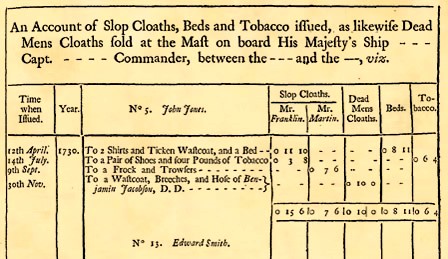
British Royal Navy (1730)
The sale of clothing belonging to the dead is mentioned several times, particularly in regard to the ship's Purser, who was responsible for keeping "a perfect Slop-Book, Book of Dead Men's Cloaths, and a Tobacco-Book, which you are to deliver into the respective Offices, before the Pay of the Ship."5 An example of this book recording such purchased during a voyage by sailors can be seen in the image at left. Note that 'Slop Clothes' were pieces of clothing brought on the ship for men to purchase if theirs wore out during the voyage. Men in the Navy could buy the clothes, beds and possibly other possessions of the deceased and have the costs deducted from their future pay, which was received at the end of the voyage.
Some of the procedures for this auction were given in Regulations and Instructions. It began by noting that "All Slop Cloaths, Dead Mens Cloaths, and Bedding, are to be issued out to the Men publickly upon Deck, in the Presence of the Officers and Company."6 It also ordered, "No Seamen shall be permitted to bid for Dead Officers Cloaths that are above their Wear, or be suffered [allowed] to bid for any Effects beyond their real Value, according to the Judgement of the Master and Purser, who shall be present; nor purchase more than the Wages due to them can answer, agreeable to the Allowance of Slop Cloaths."7
No account of such an auction exists for any merchant, buccaneer, privateer or pirate ship during the golden age of piracy, so this may have been a practice exclusive to the navy. However, most sailors had at one time or another been aboard a naval vessel, it is likely this tradition may have been carried over to non-naval vessels.
1 Henry Teonge, The Diary of Henry Teonge, Chaplain on Board H.M.'s Ships Assistance, Bristol, and Royal Oak, 1675-1679 Teonge, 1825, p. 109; 2 Craig V. Fisher, “Royal Navy & Marine Customs and Traditions”, www.hmsrichmond.com, gathered 10/15/15; 3 Richard Henry Dana, Two Years Before the Mast, 1840, p. 47; 4 Temple Stanyan, British Royal Navy, Introductory Letter to Regulations and Instructions Relating to His Majesty's Service at Sea, 1730, p. ii; 5 British Royal Navy, Regulations and Instructions Relating to His Majesty's Service at Sea, 1730, p. 126; 6 Royal Navy, p. 71; 7 Royal Navy, p. 74

